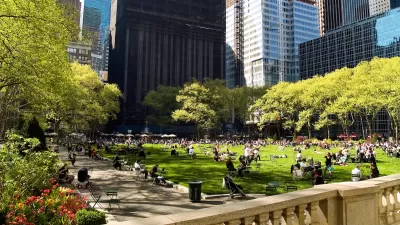Since this is my first blog, let me introduce myself. My name is Brent Toderian. In 2006 I was appointed the City of Vancouver, British Columbia’s Director of Planning. Before that I was the Manager of Centre City Planning and Design for the City of Calgary, Alberta. I am a founding member of the Council for Canadian Urbanism (CanU) which is discussed below. I look forward to your comments on this and future posts.
Since this is my first blog, let me introduce myself. My name is Brent Toderian. In 2006 I was appointed the City of Vancouver, British Columbia's Director of Planning. Before that I was the Manager of Centre City Planning and Design for the City of Calgary, Alberta. I am a founding member of the Council for Canadian Urbanism (CanU) which is discussed below. I look forward to your comments on this and future posts.
It would be a shame if Allan Jacobs' call to arms for North American planning departments, and city planning schools, in the Summer 2006 issue of Places ("The State of City Planning Today and its Relationship to City Planning Education", Volume 18, no.2) went unnoticed across planning and design circles. Here is the link to the article: http://repositories.cdlib.org/cgi/viewcontent.cgi?article=2247&context=ced/places (I suggest you read it first).
Having worked both as a municipal planning leader and private consultant across Canada, I found his comments remarkably candid, controversial and absolutely correct. This article could represent a key punctuation point in a discussion (and debate) on the future of how we plan and build cities, and educate our future city-builders on either side of the border.
I for one, am trying to ensure the article is noticed here in Canada. First, I've put it on the agenda to discuss at our annual "Big Cities Planning Directors Meeting". Second, we're making it a key piece in the National dialogue amongst many of Canada's leading urbanists representing the city planning, architecture and landscape architectural professions. This dialogue has recently led to the creation of the new Council for Canadian Urbanism, or CanU. Formed by prominent design-emphasizing practitioners from across the Country - and in particular, influential municipal design voices from planning departments of all scales - CanU has been working to address many of the challenges Jacobs describes. Perhaps it's the rare candor of Jacobs' piece that makes it so useful to this discussion.
Its true that here in Canada, we think of ourselves as having a strong tradition of municipal city planning relative to the United States (based largely on stronger planning tools at our disposal, and a tradition from our Constitution of "peace, order and good government" as opposed to "life, liberty and the pursuit of happiness" and its connection to individual property rights). As a result, we have many good planning departments across the Country, with many passionate and talented professionals.
Here in Vancouver we've had a particularly strong tradition, over several generations of planning directors, of a strong voice in shaping a "city by design". As a result, the Planning Department has enjoyed a very high public profile, and has received a rare share of the credit (deservedly shared with our many city-building partners) for Vancouver's consistent recognition as one of the Worlds most livable cities. At present we're in the process of defining our next era of city-building, with our "EcoDensity" initiative that sets ecological sustainability as our primary definition of success, and strives to make exceptionally designed higher densities with green technologies the new "business as usual" throughout the city (see www.vancouver.ca/ecodensity).
Embracing Jake's spirit of candor though, I found his description of some planning departments to be disturbingly familiar from my work across the Country. Despite the tools, too many planning departments are too quiet, allowing their leadership voice in the politics of city-making to be muted. Others seem to emphasize the number of applications they process rapidly within a spirit of "customer service" as their key definition of success, regardless of the resulting quality of city-building. And as Jacobs points out, far too many have moved from a department of physically adept city-shapers, to the keepers of policy, demographics and rules. Urban Design is often either not present at all, or perhaps is a small piece of the department (perhaps a single individual called an urban designer, suggesting it should be considered a specialty along-side a heritage planner or a social planner, instead of a key dimension of a well rounded "typical" city planner in the department).
His observations are equally true in Canadian Planning Schools, most of whom have moved away from the physical (although thankfully some are trying to move back). But the crit should not stop with planning schools – in my observation it is also true that with the typical architecture and landscape architectural program's emphasis on individual building design or the power of the plant type (respectively), bigger opportunities to teach holistic urban design and city-making are being missed. And yet all three design professions, in their worst moments, easily seem to fall into a "turf war" over which profession is best positioned to be (and train) the city-builders of the future.
Among other things, the CanU leadership from the three design disciplines are working together to promote a return to a greater civic design awareness and emphasis at all scales. This not as an end, but as a means of better achieving the important goals of urban sustainability, healthy and complete communities, civic beautification, social and economic integration, and so on. Rather than fighting over turf, we're coming together as partner-disciplines, as urbanists, with a common goal of better urban environments, and a stronger and clearer urban agenda here in Canada. We're still in the baby step stages, but we have some of the highest profile voices in the Country among our ranks, and we're gaining momentum.
As a city-planner though, like Jacobs, my own call to arms is for my discipline. The city–planner of the now and the future, has to be a design-savvy urbanist, a generalist who never stops learning. A renaissance person for cities, who understands how the physical relates to the social, the ecological, the economic, the cultural, the marketing/ "branding", the story-telling, and so on, and can bring it all together in a physical sense. A practitioner able to channel their inner artist as well as their inner scientist, to apply both rational and intuitive thinking, and know when which is most important. A creative, open-minded lover of the complexity of cities.
Are any planning schools producing this kind of practitioner? Some educators I know suggest it's overly ambitious to try, as their students should learn all that "on the job". I disagree. That needs to be the spirit of how and what they learn right from the start. Maybe its overly ambitious, but I'd be happy if schools were trying.
The discussion that Jacobs' article spurs on is long overdue. The lack of constructive candor out there on these issues may be one of the reasons why we find ourselves where we are. Although I do think things are starting to move in the right directions here in Canada, in order for planning departments and planning schools on either side of the border to maintain, or re-gain, their relevancy, city planners and urbanists from all disciplines must be clearer and more persuasive voices in the shaping of our cities, able and willing to work with, but also challenge, the obstacles of short-term politics, the profit imperative, and NIMBY. I have tremendous faith in the three design professions, that we can be the leaders our cities need now more than ever.

Trump Administration Could Effectively End Housing Voucher Program
Federal officials are eyeing major cuts to the Section 8 program that helps millions of low-income households pay rent.

Planetizen Federal Action Tracker
A weekly monitor of how Trump’s orders and actions are impacting planners and planning in America.

Ken Jennings Launches Transit Web Series
The Jeopardy champ wants you to ride public transit.

Washington Legislature Passes Rent Increase Cap
A bill that caps rent increases at 7 percent plus inflation is headed to the governor’s desk.

From Planning to Action: How LA County Is Rethinking Climate Resilience
Chief Sustainability Officer Rita Kampalath outlines the County’s shift from planning to implementation in its climate resilience efforts, emphasizing cross-departmental coordination, updated recovery strategies, and the need for flexible funding.

New Mexico Aging Department Commits to Helping Seniors Age ‘In Place’ and ‘Autonomously’ in New Draft Plan
As New Mexico’s population of seniors continues to grow, the state’s aging department is proposing expanded initiatives to help seniors maintain their autonomy while also supporting family caregivers.
Urban Design for Planners 1: Software Tools
This six-course series explores essential urban design concepts using open source software and equips planners with the tools they need to participate fully in the urban design process.
Planning for Universal Design
Learn the tools for implementing Universal Design in planning regulations.
Heyer Gruel & Associates PA
Ada County Highway District
Institute for Housing and Urban Development Studies (IHS)
City of Grandview
Harvard GSD Executive Education
Toledo-Lucas County Plan Commissions
Salt Lake City
NYU Wagner Graduate School of Public Service






























